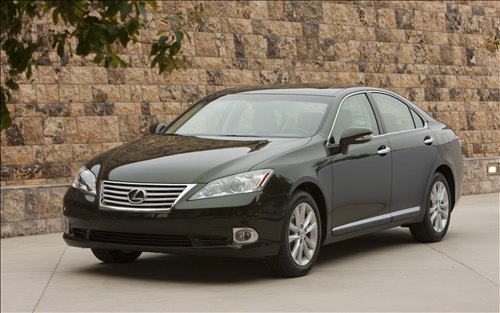The Specs
How closely related is the GX 460 to the new 4Runner? Well, they both ride on the same 109.8-inch wheelbase and the slight differences in other specifications can be attributed to slight differences in bumper, roof rack and wheel design. The outgoing
GX 470
rode on a 109.8-inch wheelbase too. This is not the case of a vehicle growing larger.
However, it is a vehicle that's gotten heavier. According to
Lexus
, the 2009 GX 470 weighed in at a full-figured 4871 pounds while the base 2010 GX 460 is an obese 5305 pounds. That's a 434-pound increase.
Fortunately, the GX 460 is blessed with a stout heart. The GX 470's iron-block "2UZ-FE" 4.7-liter DOHC V8 has been replaced by the new, all-aluminum "1UR-FE" 4.6-liter V8 DOHC V8 (which is not, incidentally, the same 4.6-liter V8 installed in Lexus cars). Featuring continuous variable valve timing and a thirst for 91-octane or better fuel (but not utilizing direct injection), the new engine is rated at 301 hp at 5500 rpm and 329 lb-ft of peak torque at 3500 rpm. That's a substantial improvement over the outgoing motor's 263-hp at 5400 rpm, but only a modest bump up from the old engine's 323 lb-ft of peak torque at 3400 rpm.
Strangely though, the GX 460's engine lags 9 hp behind the essentially identical 4.6-liter V8 installed in the
2010 Toyota Tundra pickup, and the Tundra engine is rated to operate on 87-octane fuel. Intake and exhaust-system differences are the likely power thieves here.
The sole transmission behind that new engine is the same six-speed automatic used in the Tundra equipped with the 4.6-liter V8 and a step up from the five-speed used in the GX 470. It shifts so smoothly that its operation is effectively undetectable. The full-time all-wheel drive system has an electronically controlled two-speed transfer case and a locking center differential. The standard 265/60R18 mud-and-snow tires aren't particularly aggressive by off-road standards, but the drivetrain makes every effort to help them gain traction.
Considering the amount of heft the GX 460's engine must lug, that it achieves an EPA-estimated 15 mpg in the city and 20 mpg on the highway is surprising, if not impressive. And the GX 460 is rated to tow up to 6500 pounds when equipped with the correct hitch.
The suspension uses double A-arms in front with a solid axle on coil springs located by four links in back—hardly exotic stuff. But it's complemented by a four-wheel Adaptive Variable Suspension (AVS) system and, on the rear wheels, Adjustable Height Control (AHC). Those both seem to work well enough, but the star here is the same Kinetic Dynamic Suspension System (KDSS) used on the off-road ready Trail version of the 4Runner.
The KDSS system manages the connection of the stabilizer bars to the GX 460 through the use of electronically controlled hydraulic cylinders at the points where the bars would otherwise conventionally mount to the frame. Extending the hydraulics has virtually the same effect as disconnecting the stabilizer bars and increasing suspension travel when the going gets hairy.
So that's the substance and steak of the GX 460. The sizzle comes in the details.
For some, there might be too much technology crammed into the GX 460. The dashboard, center stack and steering wheel are an absolute riot of buttons, with knobs and sliding panels that hide more buttons and knobs. Of course there's a navigation system, redundant audio controls, switches for scrolling through information displays, more switches that tell the all-wheel-drive system what to do, and, optional in Premium-grade models, a package that bundles a driver monitor, lane-departure alert system, "intelligent" high-beam headlamps and a dynamic radar-based cruise control system. You don't have to be a Luddite to be overwhelmed by the tsunami of tech, but if you are one you've got a head start.



















.jpg)